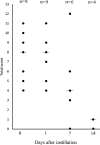Evaluation of the Live Biotherapeutic Product, Asymptomatic Bacteriuria Escherichia coli 2-12, in Healthy Dogs and Dogs with Clinical Recurrent UTI
- PMID: 29243301
- PMCID: PMC5787194
- DOI: 10.1111/jvim.14851
Evaluation of the Live Biotherapeutic Product, Asymptomatic Bacteriuria Escherichia coli 2-12, in Healthy Dogs and Dogs with Clinical Recurrent UTI
Abstract
Background: Antimicrobial resistance is an emerging problem.
Hypothesis/objective: To investigate the safety and efficacy of a live biotherapeutic product, ASB E. coli 2-12 for UTI treatment.
Animals: Six healthy research dogs; nine client-owned dogs with recurrent UTI.
Methods: Prospective noncontrolled clinical trial. For safety data, research dogs were sedated, a urinary catheter was inserted into the bladder; 1010 CFU/mL of ASB E. coli 2-12 was instilled. Urine was cultured on days 1, 3, and 8 post-instillation and dogs were observed for lower urinary tract signs (LUTS). For client-owned dogs, ASB E. coli 2-12 was instilled similarly and urine cultures analyzed on days 1, 7, and 14 days postinstillation.
Results: No LUTS were noted in any of the 6 research dogs after ASB E. coli 2-12 infusion. Pulse field gel electrophoresis (PFGE) studies confirmed the bacterial strains isolated matched that ASB E. coli 2-12 strain. Four of the nine client-owned dogs had complete or nearly complete clinical cures by day 14. Of these four dogs, 3 also had microbiologic cures at day 14; one of these dogs had subclinical bacteriuria (in addition to ASB E. coli 2-12). Three of these four dogs had ASB E. coli 2-12 isolated from their urine at day 14. With the exception of mild, temporary, self-limiting, hyporexia in two dogs on the day of biotherapeutic administration, there were no major adverse effects.
Conclusions and clinical importance: These results suggest ASB E. coli 2-12 is safe and should be investigated in a larger controlled study evaluating clinical UTI in dogs.
Keywords: Antimicrobial resistance; Cystitis; Dog; Urinary tract.
Copyright © 2017 The Authors. Journal of Veterinary Internal Medicine published by Wiley Periodicals, Inc. on behalf of the American College of Veterinary Internal Medicine.
Conflict of interest statement
Jane Sykes serves as Associate Editor of the Journal of Veterinary Internal Medicine. She was not involved in the review of this manuscript.
Figures


Similar articles
-
Evaluation of the efficacy of a live Escherichia coli biotherapeutic product (asymptomatic bacteriuria E. coli 212).J Vet Intern Med. 2024 Sep-Oct;38(5):2548-2555. doi: 10.1111/jvim.17167. Epub 2024 Sep 16. J Vet Intern Med. 2024. PMID: 39285460 Free PMC article.
-
Predictive value of Escherichia coli susceptibility in strains causing asymptomatic bacteriuria for women with recurrent symptomatic urinary tract infections receiving prophylaxis.Clin Microbiol Infect. 2012 Apr;18(4):E84-90. doi: 10.1111/j.1469-0691.2012.03773.x. Epub 2012 Feb 13. Clin Microbiol Infect. 2012. PMID: 22329638
-
Detection of Escherichia coli and Enterococcus spp. in dogs with polymicrobial urinary tract infections: A 5-year retrospective study.J Vet Intern Med. 2022 Jul;36(4):1322-1329. doi: 10.1111/jvim.16445. Epub 2022 May 27. J Vet Intern Med. 2022. PMID: 35621072 Free PMC article.
-
A review of the current concepts in canine urinary tract infections.Aust Vet J. 2022 Jan;100(1-2):56-62. doi: 10.1111/avj.13127. Epub 2021 Nov 14. Aust Vet J. 2022. PMID: 34775603 Review.
-
Asymptomatic Bacteriuria in Noncatheterized Adults.Urol Clin North Am. 2015 Nov;42(4):537-45. doi: 10.1016/j.ucl.2015.07.003. Epub 2015 Aug 11. Urol Clin North Am. 2015. PMID: 26475950 Review.
Cited by
-
Evaluation of the efficacy of a live Escherichia coli biotherapeutic product (asymptomatic bacteriuria E. coli 212).J Vet Intern Med. 2024 Sep-Oct;38(5):2548-2555. doi: 10.1111/jvim.17167. Epub 2024 Sep 16. J Vet Intern Med. 2024. PMID: 39285460 Free PMC article.
-
Urinary tract infection and subclinical bacteriuria in cats: A clinical update.J Feline Med Surg. 2019 Nov;21(11):1023-1038. doi: 10.1177/1098612X19880435. Epub 2019 Oct 10. J Feline Med Surg. 2019. PMID: 31601143 Free PMC article. Review.
-
Longitudinal examination of urine pH, specific gravity, protein, culture, and antimicrobial resistance profiles in healthy dogs.J Vet Intern Med. 2023 Nov-Dec;37(6):2219-2229. doi: 10.1111/jvim.16860. Epub 2023 Sep 8. J Vet Intern Med. 2023. PMID: 37682015 Free PMC article.
-
Evaluation of a rapid immunoassay for bacteriuria in dogs.J Vet Intern Med. 2023 May-Jun;37(3):1015-1020. doi: 10.1111/jvim.16684. Epub 2023 Apr 21. J Vet Intern Med. 2023. PMID: 37084042 Free PMC article.
References
-
- Ling GV. Therapeutic strategies involving antimicrobial treatment of the canine urinary tract. J Vet Med Assoc 1984;185:1162–1164. - PubMed
-
- Westropp JL, Sykes JE, Irom S, et al. Evaluation of the efficacy and safety of high dose short duration enrofloxacin treatment regimen for uncomplicated urinary tract infections in dogs. J Vet Intern Med 2012;26:506–512. doi: 10.1111/j.1939‐1676.2012.00914.x. Epub 2012 Apr 4. - DOI - PMC - PubMed
-
- Foxman B. Epidemiology of urinary tract infections: Incidence, morbidity, and economic costs. Am J Med 2002;113(Suppl 1A):5S–13S. - PubMed
-
- Seguin MA, Vaden SL, Altier C, et al. Persistent urinary tract infections and reinfections in 100 dogs (1989‐1999). J Am Vet Intern Med 2003;17:622–631. - PubMed
-
- Norris CR, Williams BJ, Ling GV, et al. Recurrent and persistent urinary tract infections in dogs: 383 cases (1969‐1995). J Am Anim Hos Assoc 2000;36:484–492. - PubMed
MeSH terms
Grants and funding
LinkOut - more resources
Full Text Sources
Other Literature Sources
Medical

